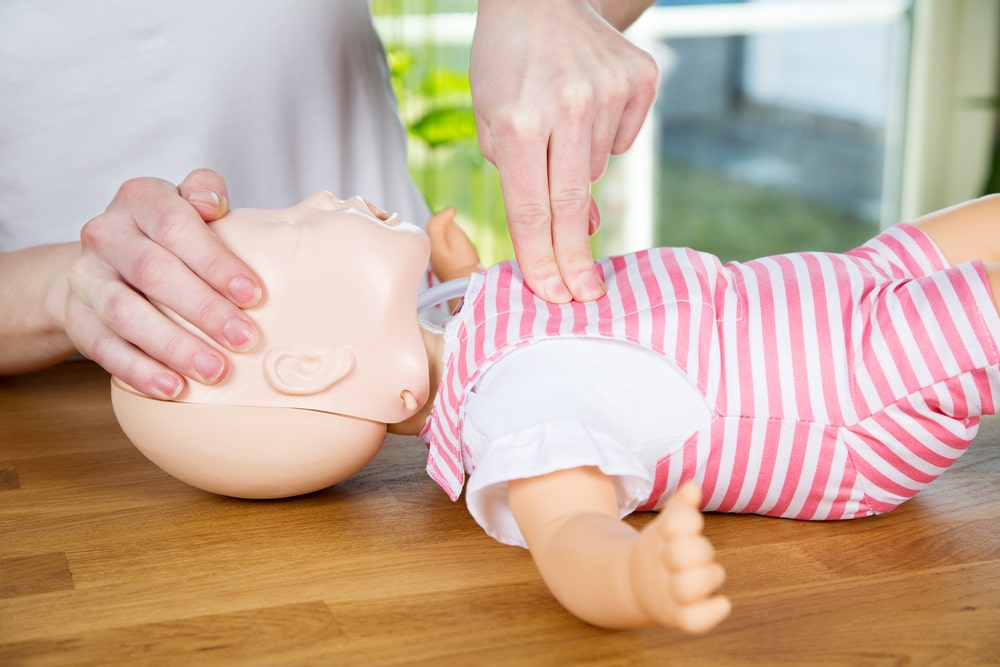Breastfeeding may be one of the most natural things in the world but that does not mean it is always easy. Many mothers find the early days and weeks of nursing difficult. Breastfeeding is a big learning curve for mom and baby and can at times feel anything but natural.
A common feeding issue for both nursing and bottle-feeding babies is choking. This can be a frightening experience and if it happens regularly can cause parents to feel anxious when the time comes to feed their baby.
So, why do babies choke on their milk? What can parents do to stop their baby choking while feeding? Luckily, there are answers and solutions to all of your worries about your baby choking on milk and you can find all the information you need here in this article.
Is It Normal For A Baby To Choke While Breastfeeding?
When we think about choking usually our minds conjure up an image of someone choking while eating solid food, their eyes wide in panic and hands clutched desperately to their throat.
Choking on milk may not be something new parents have ever thought about before they find themselves holding a coughing and spluttering baby for the first time, confused as to what is happening.
Babies choking on their milk is more common than you may think. Usually, when a baby ‘chokes’ at the breast, they cough and splutter and it can take them a few moments to catch their breath.
There are rare instances where the choking is serious enough to require a parent to administer life-saving first aid or even a trip in an ambulance to the Emergency Room may be needed.
View in gallery
Choking on milk is something new parents need to be aware of and know what to do if it happens but there is no need to be overly anxious as it is very common and can be avoided the majority of the time.
Why Is My Baby Choking On Their Milk?
The main reason your baby is choking while breastfeeding is because too much milk is getting into their mouth. Both breastfeeding and bottle feeding require babies to coordinate their breathing with sucking and swallowing.
If too much milk gets into the baby’s mouth at once then it becomes harder for them to coordinate their breathing and swallowing and this is when they start to choke.
In order to figure out the best method to help your baby to stop choking on their milk, you first need to understand why there is too much milk getting into your baby’s mouth during feeds.
The most common reasons why babies may choke on their milk are:
- An overactive (fast) letdown causing the baby to drink too fast.
- An oversupply of breastmilk causing the baby to drink too fast.
- Poor latch and/or positioning.
- Using a nipple that is too fast flowing.
If your baby appears to be drinking really fast, gulping and gasping loudly, or pulling away from the breast upset, it is likely your milk is flowing too fast for them.
When milk leaves the breast too quickly, babies often have to drink faster to keep up with the milk flow. However, breastfeeding is a tricky skill for new babies as it is, add in an overactive letdown and it is no surprise some babies come into difficulty whilst trying to nurse.
What Is An Overactive Letdown And Oversupply Of Breastmilk?
View in gallery
Letdown is the word used to describe the moments when sucking releases the hormone oxytocin in a mom’s body and her milk begins to move down through the milk ducts and flow from her nipples at the beginning of breastfeeding.
Moms can sometimes feel a tingling sensation in their breasts and nipples when their milk starts to let down. An overactive letdown and an oversupply of breastmilk often come hand in hand, making nursing challenging for both mom and baby.
When a mom produces an excess of breastmilk, this can cause her letdown to be more forceful than if her milk supply had effectively regulated.
This abundance of breastmilk can cause a mother’s letdown to be extremely powerful and the force in which the milk enters their baby’s mouth (along with the volume of the milk, too) can cause coughing and choking.
A fast letdown and oversupply of breastmilk can make nursing difficult but not impossible. There are ways to help your baby to slow down while feeding and to reduce the risk of them choking on their milk.
How To Stop Your Baby Choking On Milk
It is possible to reduce the risk of your baby choking on their milk and it is often something as simple as adjusting the baby’s position or solving the oversupply and fast letdown issues.
It might not happen straight away and there may still be the odd occasion where your baby still chokes on their milk but it is possible to teach your baby to stop drinking too fast.
Change positions
View in gallery
There are several different positions you can use to nurse your baby and some increase the risk of choking whilst others reduce it. It is best to avoid feeding positions where gravity is only going to make a fast letdown even more forceful.
For instance, any position where the mom’s nipple is pointing down into the baby’s mouth will increase the speed of the milk flow; imagine lying below a tap and someone turning it on at full speed, you are going to struggle to drink easily and comfortably that way.
Here are some breastfeeding positions to try that will help to stop baby choking on their milk:
Nurse reclining back
Sit with your baby lying the length of your abdomen instead of across your body in a traditional cradle hold, then recline back in your chair or bed so your baby is almost lying on top of your breast (rather than your breast dropping down into their mouth).
From this angle, your baby will have better control of their swallowing and without gravity exacerbating the problems, your fast letdown may not be as unmanageable as usual.
Nurse lying down
If you lay on your side in bed and have your baby facing you, this can help with choking as it is easier for the baby to let excess milk dribble from the side of their mouth.
In a traditional cradle, hold a baby is held very close to the mom, and the only way to effectively stop the excess milk flowing too quickly into their mouth is for the baby to pull away.
From a side-on angle, even with a proper latch, it is easier for the unwanted milk to drip out of the baby’s mouth onto the bed (don’t forget to place a towel down before you start a feed!). This is also a really comfortable position for mom and can be particularly useful during the night.
Another way stepmoms can take to help their baby to drink more slowly is to try and rectify their oversupply of breastmilk or address their overactive letdown issue. Here are some tips:
View in gallery
Hand express before feeds
One thing you do NOT want to do if you have an oversupply of breastmilk is to pump between feeds. Pumping will exacerbate the issue and may lead to more milk being produced.
Breastfeeding works on a supply and demand basis and if mom pumps between feeds then she is signaling to her body to make even more milk – this is not what we want at all!
What you can do though is hand express before a feed, just relieving the pressure and allowing the forceful letdown to happen before you latch a baby onto your breast.
As choking is most common during the initial letdown, if you start feeding your baby after this milk has already come out then they should be able to feed more comfortably.
Block feeding
Block feeding can be used as a method to correct an oversupply of breastmilk. Block feeding is when a breastfeeding mom feeds her baby just from one breast for several feeds in a row.
The unused breast becomes overly full and this will send signals to the body that it is making too much milk and doesn’t need to continue to produce milk at this volume. You then repeat the process on the other side until your milk supply has regulated to match your baby’s needs.
Avoid breastfeeding supplements
Whilst some moms take supplements to boost their milk supply if you have an oversupply of breastmilk you should not take these nursing supplements. You don’t want to take anything that promises to up your milk production.
You are making more than enough milk right now mama and if you are eating a healthy balanced diet you don’t need to worry about taking any additional supplements.
Position To Stop Bottle Fed Babies From Choking On Their Milk
View in gallery
It is not just breastfed babies that drink milk too fast and choke.
Choking is a common issue for bottle-fed babies too and bottle-feeding parents will also benefit from knowing how to reduce the risk of choking and help their baby drink their milk more slowly and safely.
The main reasons bottle-fed babies choke are poor positioning and the wrong size bottle nipple.
If you are sure the nipple is the right size for your baby and is not the reason your baby is drinking too fast, then it is time to try and feed them in a different position.
Hold baby upright
Again, gravity is not a baby’s BFF when it comes to bottle-feeding time. If you feed a baby while they are lying flat on their back, either in your arms or in their crib, then gravity will cause the milk to flow more quickly.
Sit your baby high up your arms, hold them diagonally across your body so their head is higher than the rest of their body. When feeding your baby a bottle keep the bottle parallel with the ground and make sure the base of the bottle stays in line with the nipple.
If you hold the bottle at an angle and point it into the baby’s mouth, the milk will flow more quickly and the baby will have less control of the speed at which the milk enters their mouth.
Holding the bottle so a baby has to work to get the milk out and can pace their feed, is a method of bottle feeding that more closely replicates breastfeeding and also reduces the risk of choking.
What To do If Your Baby Is Choking On Milk?
Now you know why your baby may be choking on their milk and have all the tips and advice you need to help them feed more comfortably and safely. However, sometimes choking can not be avoided and it is important parents know what to do if their baby is choking.
View in gallery
Take the milk away
The first thing to do if your baby is choking is to either remove them from the breast or take the bottle from their mouth. There is too much milk in their mouth already and you don’t want to add any more.
Your baby will be coughing and spluttering and struggling to catch their breath, if this happens take their milk away immediately.
Position baby upright
Lift your baby up so they are in a vertical position and gently but firmly tap and rub their back. This should encourage them to spit up the excess milk, making it easier for them to breathe properly again.
Administer infant CPR
If your baby continues to be unable to catch their breath then it is time to administer infant CPR. It is a good idea to take a newborn and child first aid course during your pregnancy so you are equipped with all the knowledge you need prior to your baby’s arrival.
If your baby turns blue and falls unconscious you must call for an ambulance immediately.
How To Administer Infant CPR
New parents are advised to take an infant first aid course during pregnancy. A first aid course can prepare parents with the knowledge they need to deal with any emergency if the worst were to happen once their baby has arrived.
There are also several videos online demonstrating vital first aid, including infant CPR. We encourage you to learn as much first aid as possible but here is a breakdown of baby CPR so you can learn the basics now.
View in gallery
- Place baby over the length of your forearm and support their neck and head with your hand, baby should be facing the floor. Administer five firm backstrokes down your baby’s back towards their head.
- If your baby is still not breathing, turn them over onto their back and give them five chest thrusts.
- Continue to alternate between five backstrokes and five chest thrusts until your baby regains consciousness or the emergency services arrive.
The Final Thought
Newborns and young babies drink a lot of milk every single day and feeding should be a peaceful time for bonding, not a time full of anxiety and stress.
Now you know why your baby is drinking too fast, how to reduce the risk of your baby choking on their milk, and what to do in an emergency if your baby is choking.
We hope you can feel a lot more relaxed when it comes to feeding and is able to enjoy the milky cuddles with a new peace of mind.
For a full feeding guide. check out our Guide to Feeding Baby.






